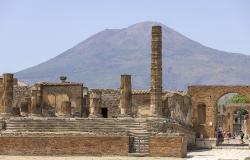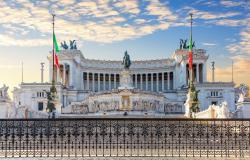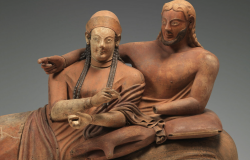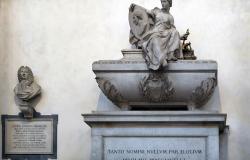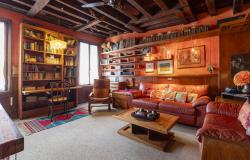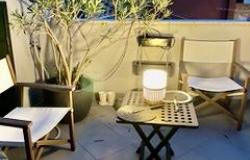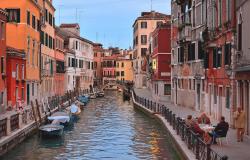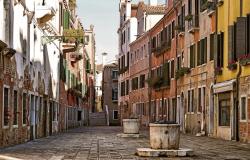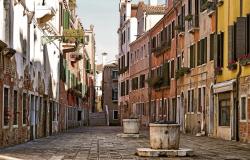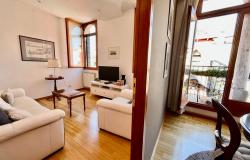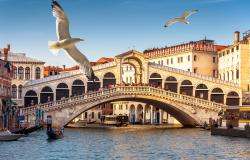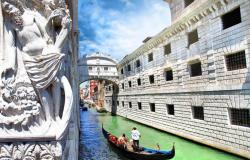I often wonder when Ruskin wrote his great work The Stones of Venice whether he knew where the stones actually came from and how they were transported there.
In the sleepy faded spa town of Battaglia Terme not far from Padua lies the key to the building of the great and unique city of Venice. The Euganean Hills around Battaglia Terme is an area of extinct volcanoes and hot springs, now a national park and an area favoured particularly by German tourists for its spa treatments and its wines. But at some point a thousand or more years ago it must have been discovered that the volcanic stone quarried there provided the perfect paving stones for the passages and alleyways of Venice, having a rough texture which prevented slipping, an important factor in a city based on water.
Canals provided the easiest means of transporting these stones from Battaglia to Venice, and in consequence a network of navigation systems sprang up and remained in use until the mid 20th century. Amazingly, the Battaglia Canal was constructed between 1189 and 1201, preceding by several centuries the canals of the English Industrial Revolution. Italian canals were often built at ground level with walls and banks to contain them, rather than dug out in trenches as ours were.

Paving stone - Venice
The Museum of Navigation in Battaglia Terme has been the life’s work (or at least the past 30 years) of the canal’s last bargeman, the visionary Riccardo Cappellozza. He tells the story of how he was chatting to his friend the local librarian about his work now that he was about to retire. They both realised that a whole language was about to disappear. Riccardo supplied the nouns for the tools and equipment, the verbs for the movement of cargo and business of sailing, and the stories about life on the barges. From that small beginning, he began to collect the abandoned materials of his trade from whole boats to tiny hooks. The collection grew. Space was needed. Not everyone recognised the importance of all these objects, but some enlightened fellow citizens offered him the former abattoir to house the still-growing collection.
 SS16 Padua-Ferrara road follows the Battaglia Canal, and the entrance to the little town is across a modern bridge where various boats have been pulled up onto dry land, one eerily with a life-like figure keeping an eye on the traffic. This is the furthest outpost of the museum’s collection, next to boat sheds where the canal widens to permit barges to be stored and brought out for the town’s festive occasions, for rides to Catajo Castle and back for one euro. The museum itself is tucked away behind the main road, but could hardly be missed with its colourful assortment of anchors, mooring posts, buoys etc displayed in front of the entrance.
SS16 Padua-Ferrara road follows the Battaglia Canal, and the entrance to the little town is across a modern bridge where various boats have been pulled up onto dry land, one eerily with a life-like figure keeping an eye on the traffic. This is the furthest outpost of the museum’s collection, next to boat sheds where the canal widens to permit barges to be stored and brought out for the town’s festive occasions, for rides to Catajo Castle and back for one euro. The museum itself is tucked away behind the main road, but could hardly be missed with its colourful assortment of anchors, mooring posts, buoys etc displayed in front of the entrance.
To enter the museum is to time-travel to a gentler age of beautiful hand crafted tools and a slower pace of life. But times change, and with the recent economic crisis the museum was about to close, with everything going into storage. Luckily, however, support from unexpected quarters has helped to save this valuable collection for posterity.

Battaglia Canal
On one of my frequent trips to Battaglia last year I met a very despondent-looking Riccardo Cappellozza, who grabbed my elbow and propelled me into the nearest bar for an espresso.
“Our museum has to close,” he said. “We no longer have a sponsor, and next year will be our last.”
He sighed deeply into his thimbleful of coffee, almost on the verge of tears.
I felt indignant. Here was the most wonderful original collection, and it was all going to waste, to be turned into a warehouse instead of being brought to life by an enthusiast who had lived the life the museum portrays. Something had to be done, but what?
Over the next weeks I mulled it over. I knew nothing about canals other than what Riccardo had taught me. One of the difficulties was that the museum wasn’t well known, and off the beaten track. I was sure that more visitors would come if they only knew about it.

Museum of Inland Navigation - Battaglia Terme
I needed to find a gonzoogler for advice. What, you may ask, is a gonzoogler? I learned this wonderful word from a friend, Clare, whose family went on canal boat holidays when she was a child. Gonzoogling is a word coined to describe the business of leaning on a lock gate and watching the comings and goings of barges passing slowly through. I reasoned that Clare would be able to identify a new audience for the little Italian museum amongst English canal enthusiasts and gonzooglers.
A few weeks later the two of us set off on a tour of canals in the vicinity of Oxford. Stoke Bruerne, a picturesque village in Northamptonshire, has a small museum on the banks of the canal near a lock, not far from one of the country’s longest canal tunnels. Obviously this is a perfect spot for gonzoogling. Chatting to David Henderson, in charge of the museum, was fun. Like his counterpart in Italy he’s an enthusiast, and it wasn’t hard to tempt him into a twinning arrangement with my little museum, with prospects of visits, cultural exchanges and Venice almost on the door step.
I relayed the good news to Riccardo on my next visit. It was just the nudge he needed to push ahead making contacts to try to find a new sponsor now that he was managing a museum with international connections. He changed overnight from being a dejected individual to a man with a mission.
“Ciao, stella!”
It was Riccardo ringing me from Italy a couple of weeks later, and shouting because I’m foreign and have difficulty understanding. He can’t pronounce my name so he calls me his star instead. I held the phone away from my ear and attempted to decipher what he was telling me. As far as I could gather, here was a very excited master bargeman who seemed to have found a new sponsor for his museum, Civiltà dell’Acqua.

Museum of Inland Navigation - Battaglia Terme
On my most recent visit to the museum, I was surprised to discover that a new exhibit has found its way onto the walls of the Museum of Inland Navigation, which I find both touching and amusing. It is a large framed photograph of me standing amongst the ropes, sails and pulleys on display there. The caption reads:
“To Myra Robinson, the Queen of the Waterways, in recognition of her work in building a cultural bridge between the waterways of southern England and the Museum of Navigation.”

